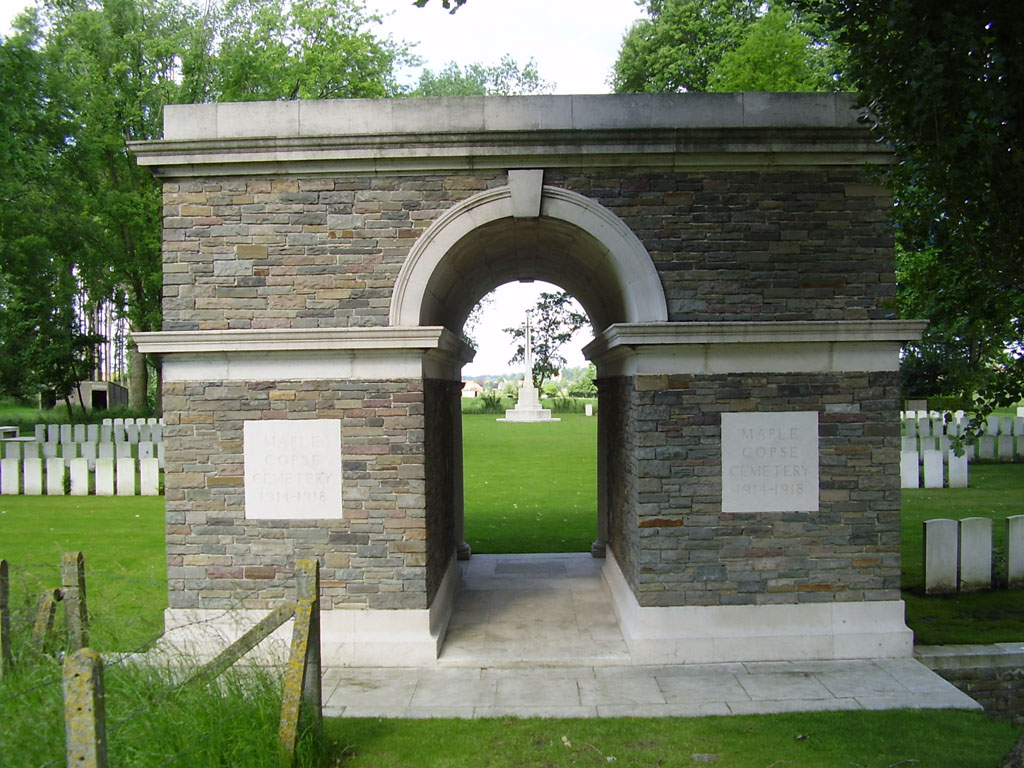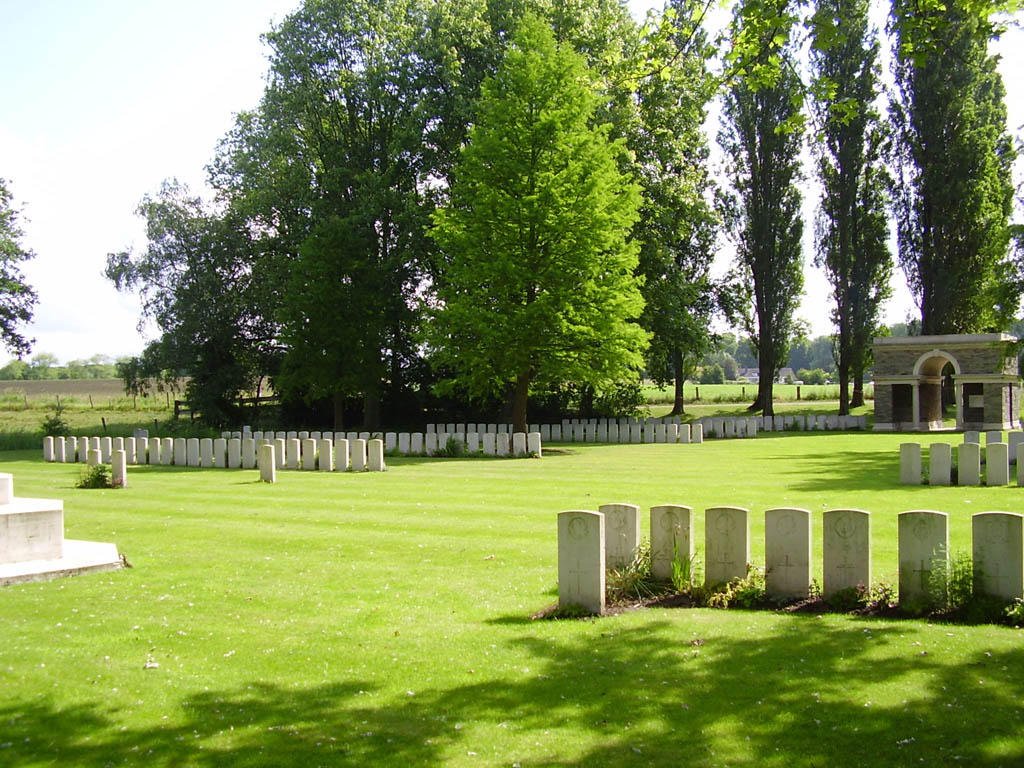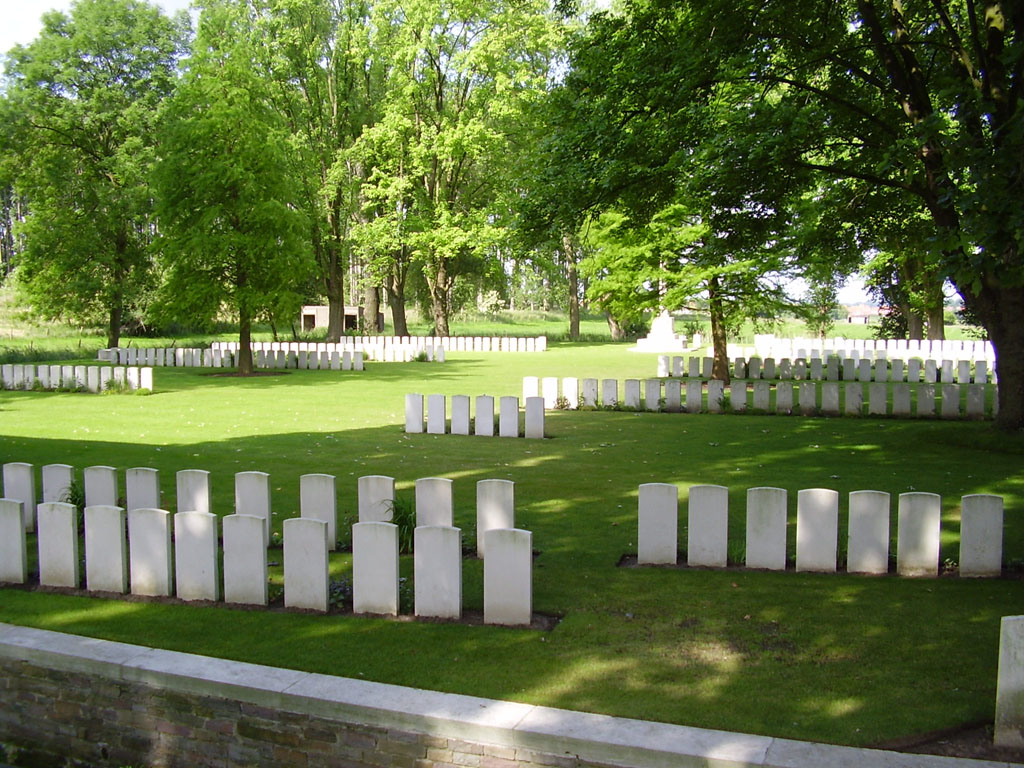Maple Copse Cemetery
- Country Belgium
- Total identified casualties 258 Find these casualties
- Region West-Vlaanderen
- Identified casualties from First World War
- GPS Coordinates Latitude: 50.83549, Longitude: 2.93913
Location information
Maple Copse Cemetery is located 5 Kms south-east of Ieper town centre, a road leading from the Meenseweg (N8), connecting Ieper to Menen.
From Ieper town centre the Meenseweg is located via Torhoutstraat and right onto Basculestraat. Basculestraat ends at a main cross roads, directly over which begins the Meenseweg.
2.5 Kms along the Meenseweg shortly after Birr Cross Roads Cemetery, lies the right hand turning onto Wulvestraat. 1 Km along the Wulvestraat is the left hand turning onto Schachteweidestraat. The cemetery itself is located 2 Kms along the Schachteweidestraat on the right hand side of the road.
Visiting information
ARRIVAL
The cemetery is at the side of a single-track metalled road with a stream running around the perimeter of the cemetery.
PARKING
There is a small layby area under trees close to the right hand on the corner of the cemetery, there is space for 2 to 3 vehicles to park.
The ground is mostly flat, but uneven in patches, the surface is a mixture of sand, earth and gravel.
The main road runs along the side of the parking area and is 5 to 10 cm higher that the parking area. A grass verge leads to the entrance of the cemetery, approximately 35 metres form the parking.
ACCESS LAYOUT AND MAIN ENTRANCE
The cemetery has a stream around the front and side. The stream is walled off from the cemetery which is raised on higher ground. The boundary wall along the stream is level with the grass inside the cemetery and drops off on the stream-side.
A tree lined and sloped grass bank runs downhill from the road to the main entrance. The ground is firm.
There is a 5-centimetre stone step up to the entrance from the paved area over the stream in front of the memorial archway.
The width of the archway is 150 centimetres. There is paving leading under the archway into the cemetery. The paving is level with the grass inside the cemetery through the two columns at the end of the paving. There is a drop down of 5 centimetres to the grass on the outer sections of paving on the outer sides of the columns.
The Register Box is located inside the memorial arch on the right-hand wall. There is seating on either side of the archway under an enclosed paved area looking into the cemetery.
The Cross of Sacrifice is at the rear of the cemetery in line with the memorial archway entrance.
There are stone bench seating areas on either side of the cemetery at the midpoint of the site on paved platforms 7.5 cm higher than the grass.
There is a wooden bench outside the cemetery close to the parking area along the road-side verge.
Internal cemetery paths are grass; the ground is flat and firm.
ALTERNATIVE ACCESS
There are no alternative entrances into the cemetery, access is through the main entrance.
ADDITIONAL INFORMATION
The cemetery is permanently open.
History information
The commune of Zillebeke contains many Commonwealth cemeteries as the front line trenches ran through it during the greater part of the First World War.
Maple Copse was the name given by the Army to a small plantation about 900 metres east of the village of Zillebeke, and just west of Sanctuary Wood. The place was used by Advanced Dressing Stations and burials took place there both before and after the Battle of Mount Sorrel in June 1916. However, in that engagement, and in later fighting, the graves were mostly destroyed. The site of the cemetery, on the north side of the copse, was enclosed after the Armistice, but of the graves known to exist there, only a small number could be definitely located.
The cemetery now contains 308 burials and commemorations of the First World War. Of the 78 burials that could be located, only 26 are identified and special memorials commemorate 230 casualties whose graves in the cemetery had been destroyed.
The cemetery was designed by Sir Edwin Lutyens.




